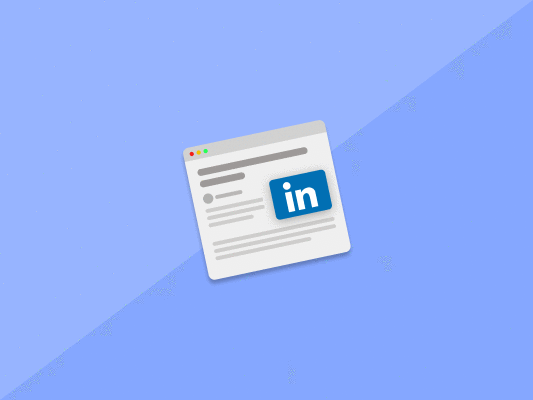LinkedIn advertising is an excellent strategy for B2B companies. This is everything you need to know about setting up your LinkedIn advertising campaign.
LinkedIn is an online service-oriented towards business and employment.
It was launched in 2003 to be mainly used for professional networking.
The platform allows employers and job seekers to post jobs and CVs respectfully.
LinkedIn allows its members, job seekers, and employers to create profiles that can help them quickly connect in the online social network.
It’s a relationship that represents real-world professional relationships.
Thus, LinkedIn has become the most popular platform for content distribution, which has made it an invaluable B2B platform.
LinkedIn advertising is an excellent investment as a business-to-business company.
Ads posted on LinkedIn yield high-quality leads and help you target larger niches/ demographics.
While social media apps are quite useful when targeting customers based on where they are active most of the time, LinkedIn has 600 million professionals.
It’s where most business-minded individuals interact.

However, LinkedIn advertising takes a different approach than the other types of paid advertising since it has a unique demographic.
So, how should you go about advertising on LinkedIn?
Read on to find out.
Setting Up Your LinkedIn Ad Campaigns In 5 Steps
1. Set your campaign objective
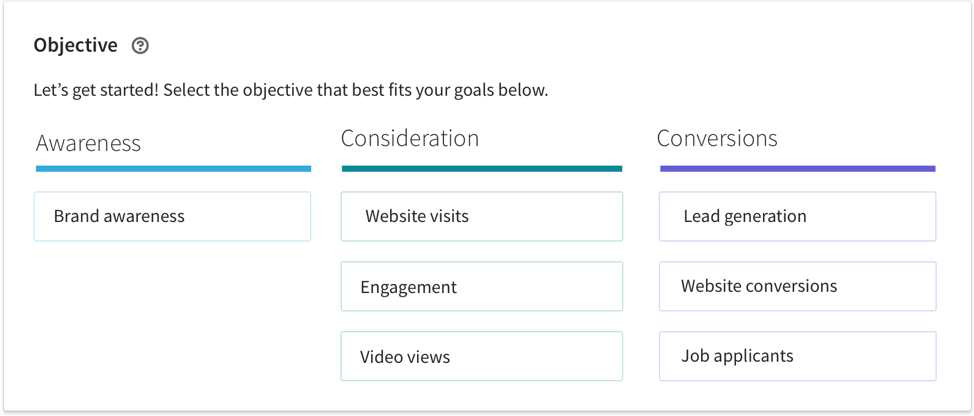
When you create a LinkedIn ads campaign, you’ll need to have some objectives that will guide you and help you make the right decisions.
Such objectives describe the intended result.
Your campaign objectives when you create LinkedIn ads include awareness, consideration, and conversion.
Awareness
Increasing your brand awareness through LinkedIn advertising can be quite beneficial since the platform is host to other like-minded people.
If your company is a B2B, making LinkedIn users aware of your brand and its reputation could boost your company’s growth and create a steady sales pipeline.
Consideration
In campaigns, considerations are actions taken by your target customers as a result of interacting with your advertisement.
The actions may include clicks that redirect them to your website’s landing page or even engagements that encourage social interactions.
Conversion
Conversions are those actions that you may define as valuable to your business, such as submitting leads, making purchases, downloading content, and even registering for events.
Tracking conversions helps you assess how successful your campaign was.
2. Sort your target audience
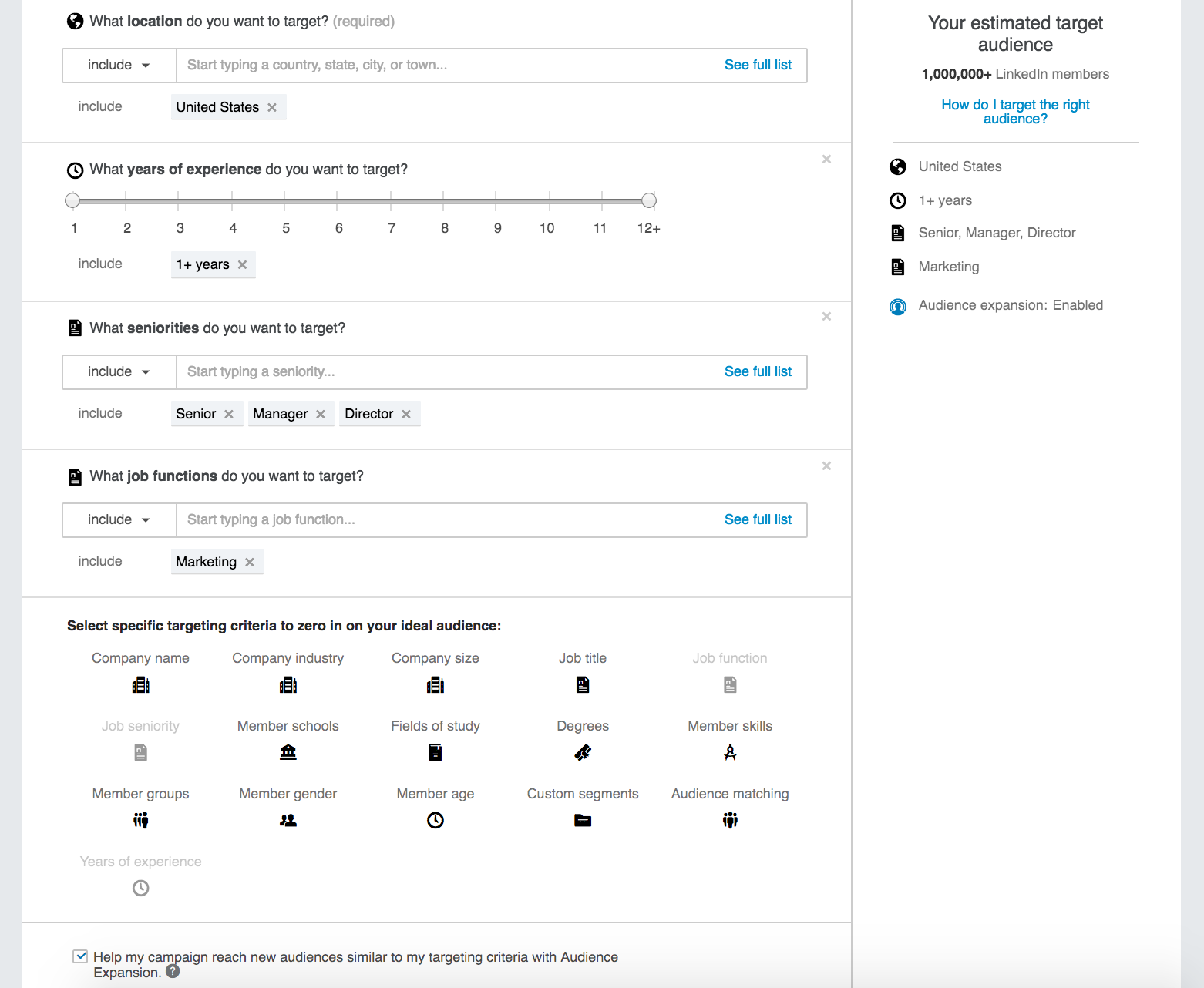
Demographic
Since LinkedIn includes people from all demographics, you could tailor your advertisement to reach out to the optimum demographic who are more likely to respond and convert.
You could tailor your ads for different demographics such as:
- Age
- Gender
- Location
- Income
- Education
Company
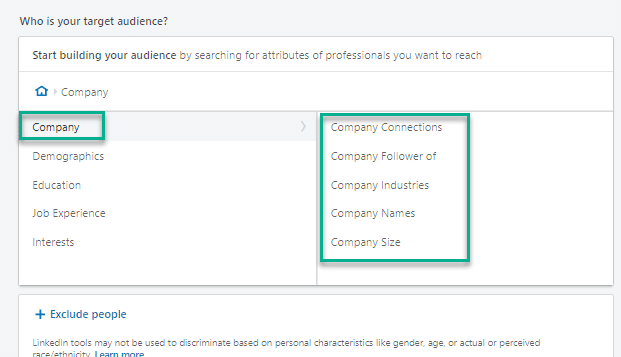
There are various company properties that you could use to reach your target audience, such as:
Company connections
This property allows you to reach 1st-degree connections with employees from companies you select.
However, the property is only available for companies that have more than 500 employees.
Company followers
You could target your company followers by viewing the page in admin view and select followers from the analytic drop-down menu.
You could then access the all followers section to target your ads to users following your company page.
Company industries
You could also reach LinkedIn users employed in industries based on the primary industry listed on company pages.
Company names
You could also target LinkedIn advertising to reach employees using their company name as listed in their profile.
Company size
You could also target your ads to reach individual employees depending on their company’s size.
Jobs targeting
Job functions
You could target your ads based on the employees’ job functions.
For instance, you may choose “Information technology” as the job function and target these individuals.
Job seniority
When targeting based on job functions, you could go one extra step and target employees based on their seniority.
Add “Director” as a seniority rank, and you will get results for IT directors in relevant companies.
Job titles
You could also target individuals based on the job titles entered in their profiles, e.g., Web Designer.
Member skills
You could target your customers based on their skills listed in their profile or those gleaned from endorsements or connections.
Years of experience
The number of conversions you make may be affected by your target audience’s years of experience.
Targeting your advertising campaign to your optimum audience based on their years of experience could help you get more conversions.
Education
Degrees
If the amounts of sales you make depend on customers with a certain level of education, such as a degree, then you could filter potential customers based on this factor and target them with your ads.
Fields of study
Much like degrees, you could also target your potential customers based on their field of study if your products or services are under demand from experts in that field.
Member schools
Since LinkedIn users state the schools they graduated from, you could target your advertisements towards users from similar member schools.
Interest
Member groups
You create LinkedIn ads to target members who join various groups that align with your company’s interests.
Such members present a more manageable target since they are more likely to convert.
Member interests
Interest targeting in LinkedIn advertising helps you focus on what members read, like, comment, share, or follow.
Much like member groups, targeting such groups could provide you with customers with a higher probability of converting.
Location

Targeting members based on their location is quite useful as opposed to blind targeting.
It allows you to direct your advertising to people from places such as your company’s primary location, where you are more likely to make more conversions.
Through LinkedIn, you could target members through their location as stated in their profile or through their IP address with geo-targeting.
Audience expansion
This type of targeting helps you display your advertisement to audiences with similar attributes to your target audience.
The strategy will help you discover new high-quality prospects that you can automatically drive into the marketing funnel.
For instance, if your campaign involves audiences who’ve listed “Online advertising” as a skill, you could use audience expansion to expand your audience to members who’ve listed interactive marketing as a skill on their profile.
Matched audience
Targeting your advertising to matched audiences is a great way to produces richer results.
With this strategy, you could retarget your website’s visitors, contacts from your customer database, and marketing automation platforms where you have a higher probability of making more conversions.
Such users already know your brand and are more likely to convert.
3) Choose a Type of LinkedIn Ads
i. Sponsored content
LinkedIn sponsored content is a paid advertisement that allows companies to distribute page updates beyond their current page followers on the platform.
These targeted page updates are visible and free on the LinkedIn page or their existing followers’ feed.
These types of LinkedIn ads come in three formats:
Single image ads

These sponsored ads include a single image that appears directly in the LinkedIn feeds belonging to professionals.
You can reach out through desktops or mobile devices.
They support all levels of funnel marketing and can be used in various objective-based advertisements.
You could include a CTA.
Video ads

LinkedIn video ads help you tell your company’s story and provide you with a better opportunity to grow your brand awareness and place yourself as a thought leader.
This advertising format is quite useful since most users prefer watching a video as opposed to reading text.
The videos are displayed in the user’s LinkedIn feed.
Carousel ads
This form of advertising features a series of swipeable cards that you could use to display your products and offers to your target audience.
You could customize them to provide interactive stories with destination links, captions, and unique images for better results.
ii. Message ads
Message ads allow you to engage with your audience using direct messages directly.
The ads get delivered to your target audience using LinkedIn messaging.
You could include custom greetings, call-to-action buttons, text, and even add a link.
They drive a 2x stronger engagement and deliver a targeted message that the user is more likely to respond to.
The fact that you could tailor your messages to fit the user’s character is an added benefit since it’ll make the message feel personal, and the user will have higher chances of connecting with it.
iii. Dynamic ads
You can use dynamic ads to reach a broader range of audiences.
You can personalize them to each recipient based on their personal information found on the platform.
Their ability to adapt to each user helps increase the probabilities of a positive response making this type of advertising very efficient.
This type of advertising has three formats:
Follower ad
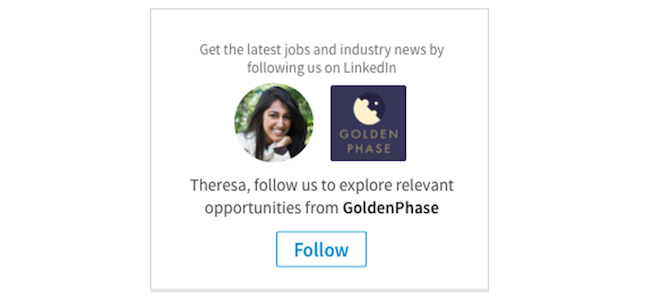
Follower ads are tailored to connect with users and persuade them to follow your LinkedIn page.
The ads feature the user’s photo and your company’s logo, and their first name together with your company’s name.
The ads are great for increasing brand awareness and engagement.
Spotlight ad
Spotlight ads are also tailored to members based on data found in their LinkedIn profiles.
These ads are meant to redirect them to your website or landing page once you click on them.
You could use them to showcase your products, events, or services.
Jobs ad
LinkedIn job ads are used to help employers redirect top-notch, talented, and relevant job seekers to apply for a job in your company.
You could promote any number of jobs and increase traffic to your active job openings depending on the member’s skills and experience.
iv. Text ads
These are intuitive, self-service pay-per-click (PPC) or click-per-impression (CPM) ad formats that help you create, optimize, and manage custom campaigns in a short period.
You could use these ads to target premium professional audiences.
In return, they could also help you drive high-value leads to your business.
With this form of advertising, you could choose which professional audience you’d like to target.
Pay for the type of advertising that works for you (either PPC or CPM).
You can even track the number of leads through conversion tracking.
Either LinkedIn ads cost strategies are quite useful.
However, they require you to be thorough since you’ll be paying for the advertisements.
You’ll need to look at the most relevant keywords that have a high commercial value.
How do you get these keywords?
BiQ’s Keyword Intelligence
What is BiQ, and how can it help?
BiQ is a complete SEO suite that you could use to get comprehensive keyword analysis, content optimization, and keyword rankings.
So, how do you go about using BiQ’s Keyword Intelligence to get the most relevant keywords for your campaign?
LinkedIn users are more likely to search for keywords that have a transactional intent since you’ll be targeting users most relevant to your B2B niche.
BiQ’s Keyword Intelligence tool can analyze and determine the user’s intent when searching for specific keywords.
For instance, let’s use the keywords “car repair services.”

After keying in this keyword in BiQ and running the analysis, you’ll find out that the keyword is mostly used by users who seek information.
However, you can filter the results by searching for keywords that contain transactional intent only.

Such keywords are great for your LinkedIn text ads since you can use them to connect more with members who are more likely to make purchases.
4) Determine Your Budget and Schedule

You could set a schedule for your LinkedIn advertising campaign with a start date and an end date.
You could continually run the campaign from the start date.
However, you have to note that this schedule doesn’t have an end date.
You could also schedule when you want your campaign to start and when it should end.
You’ll also need to calculate the time it takes to approve your advertisement and give an allowance for the ad to be viewed.
There are three different bids when it comes to such campaigns, and they all have varying costs:
Cost per send
The cost per send is billed whenever you successfully send a message to your prospects.
Such messages cost around $0.20 with a minimum campaign spending of $25.
Cost per click

In a cost-per-click advertising campaign, you’ll need to pay every time users click your ad.
The campaign is usually used for lead generation and event registration.
The average payment for cost per click is around $5.61 per click. Read this article to know more about cost-per-click.
Cost per impression
Cost per impression involves paying whenever a user stumbles upon your ad.
The average pay for cost per impression is about $6.59 for every 1000 impressions.
5. Track Your Campaign

To help you know how your advertisement campaign is faring, you could use LinkedIn’s campaign manager.
You could use this tool to monitor the impressions, clicks, and budget.
According to Theb2bhouse, a reasonable conversion rate on LinkedIn ad campaigns needs to be around 5% to 15%.
Wrapping it up
These are all the steps that you’ll need to make when advertising your company on LinkedIn.
When done right, you could reap lots of benefits through conversions and brand awareness.
Have you tried advertising on LinkedIn?
What was your experience?
Let us know!



